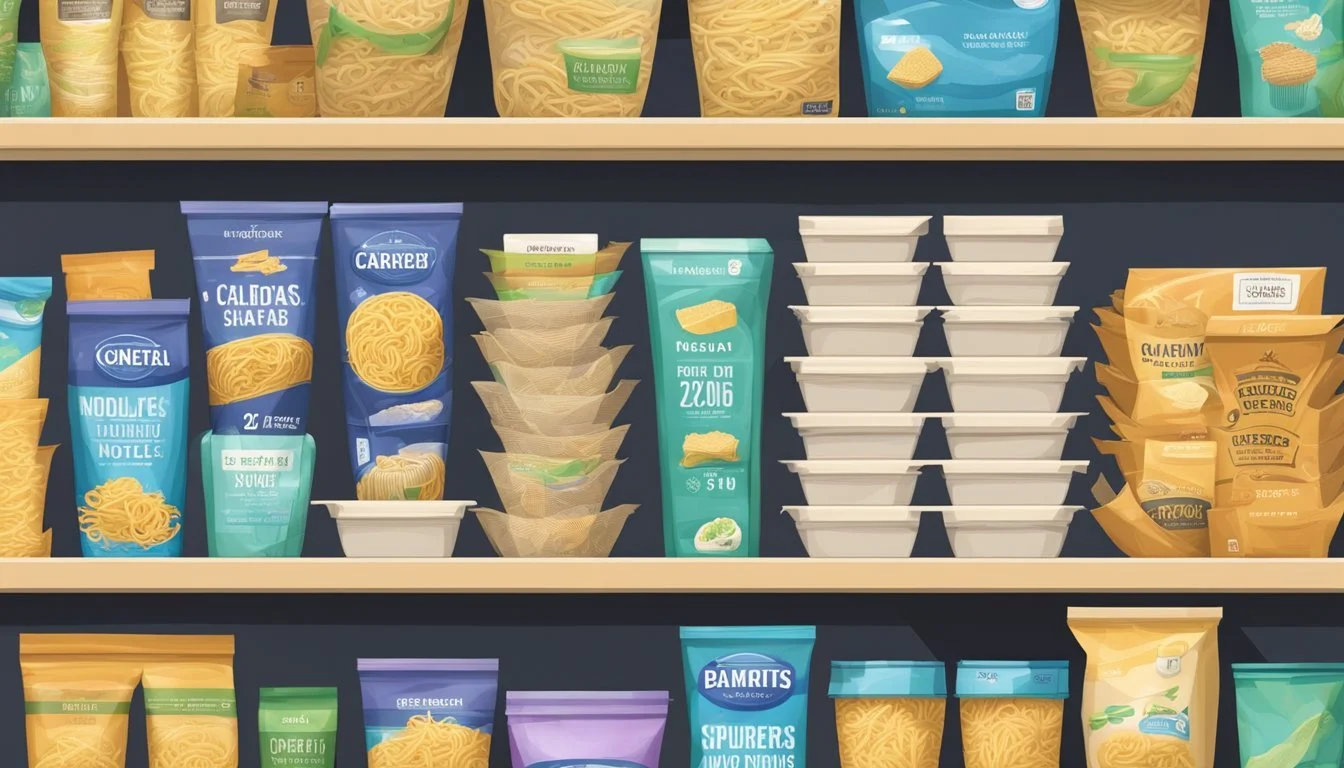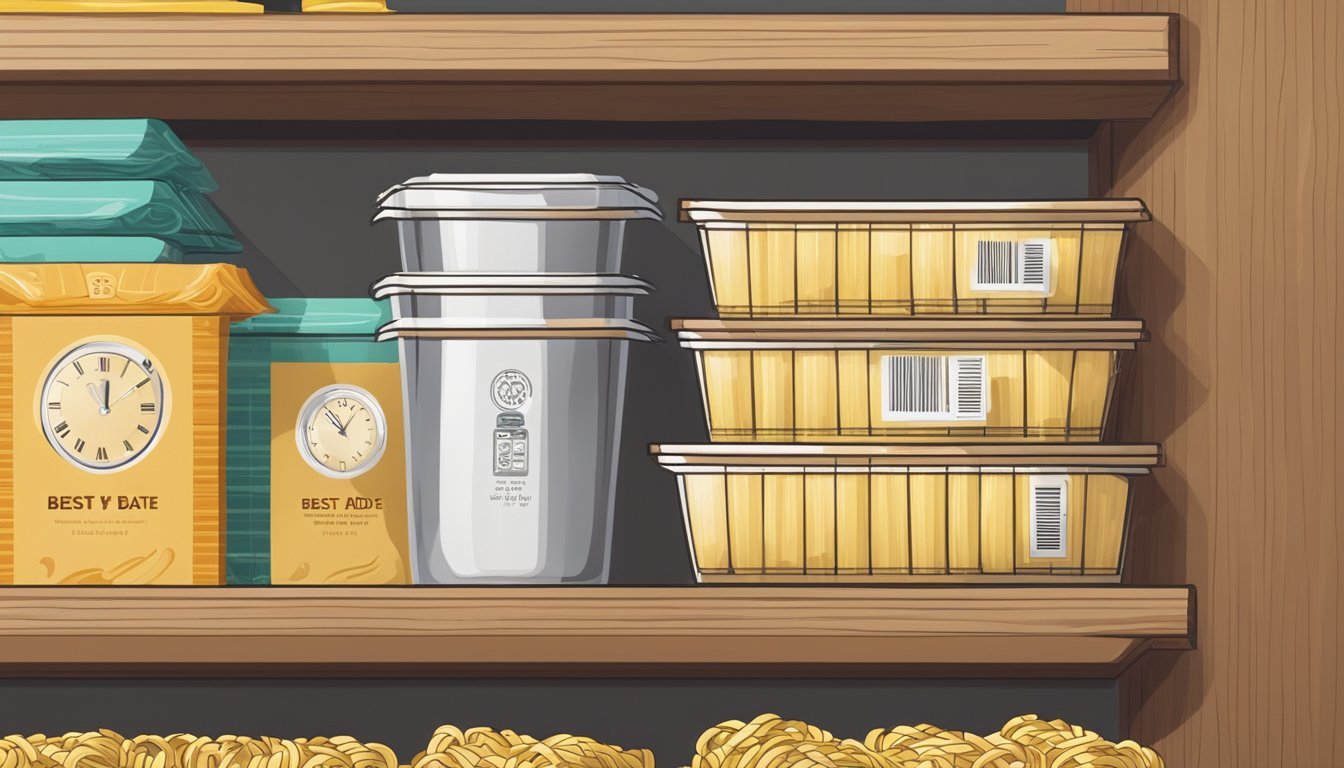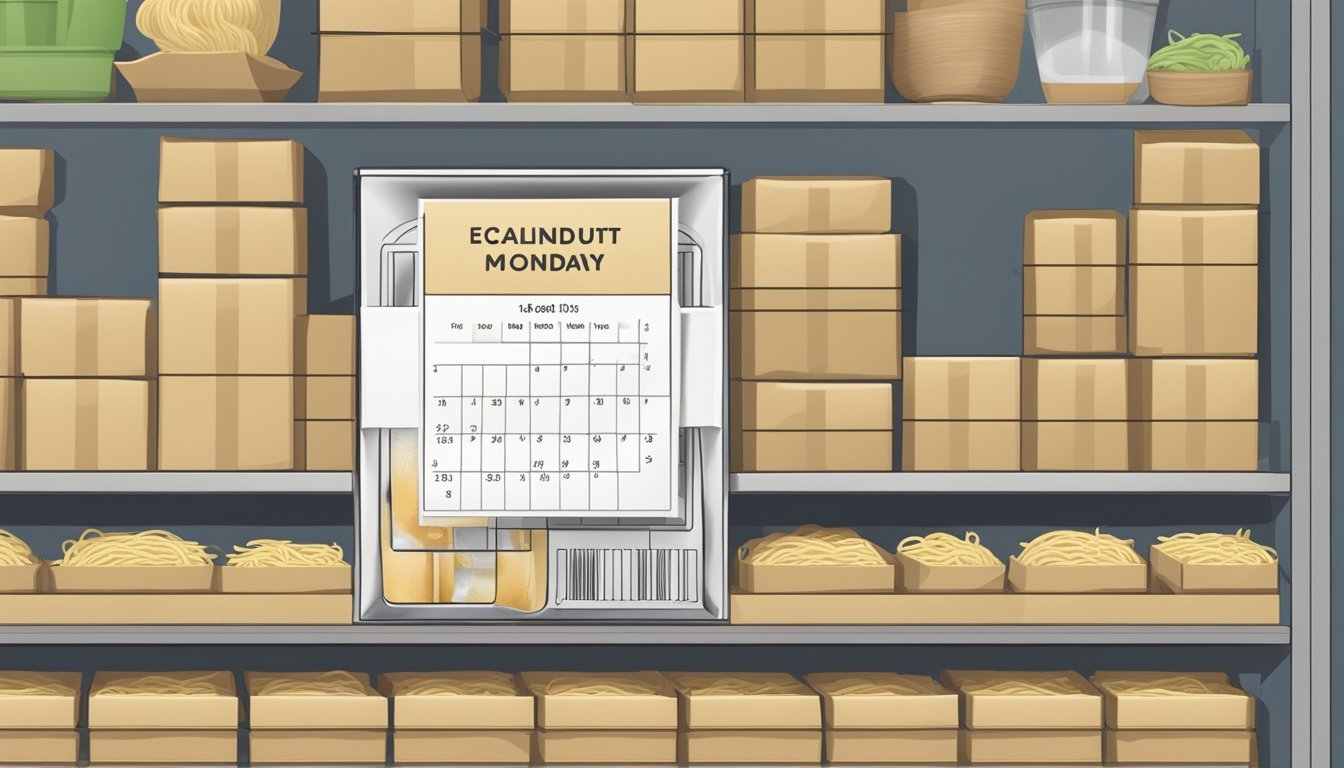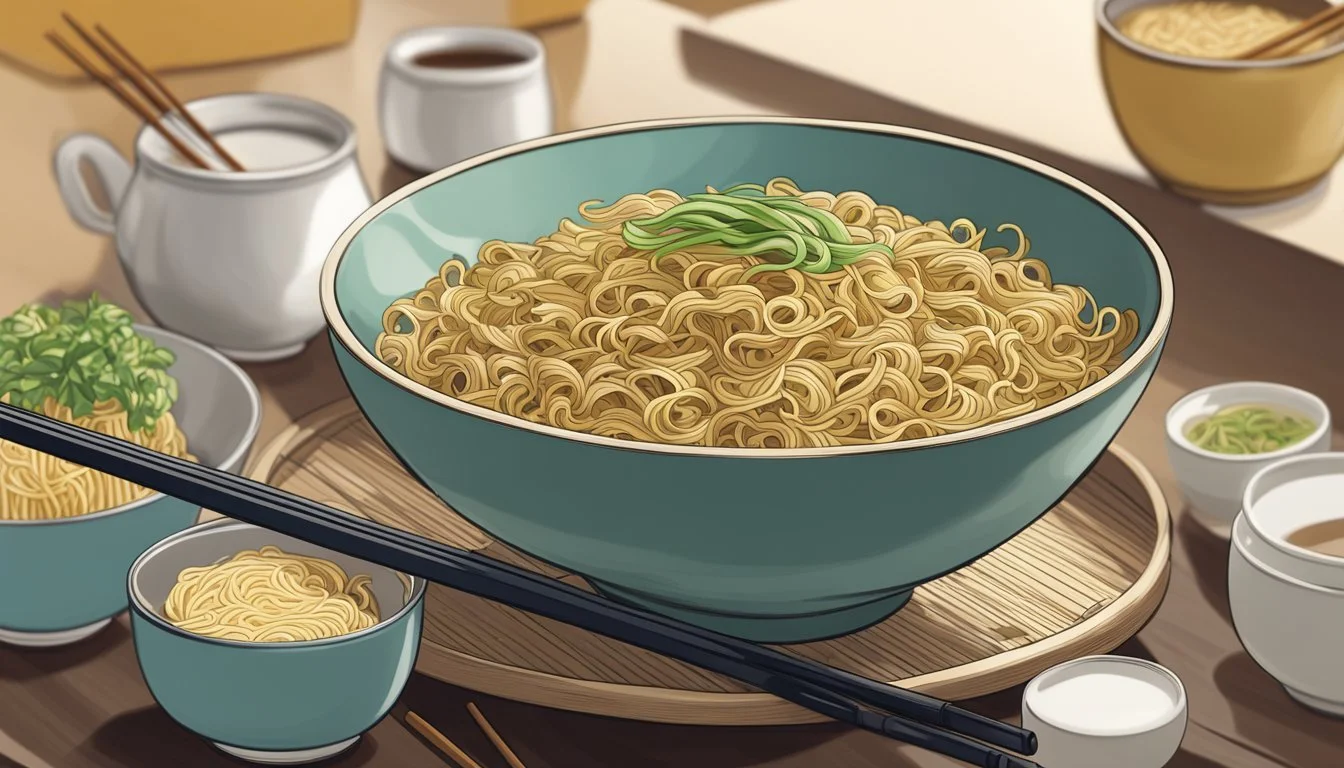How Long Do Noodles Last?
Shelf Life and Storage Tips
Noodles, in their various forms, are a staple in many diets around the world, valued for their versatility and long shelf life. Yet, the longevity of noodles is not indefinite and is influenced by multiple factors, including the type of noodle, storage conditions, and whether they are dried or fresh. Dried noodles can last significantly longer than their fresh counterparts, often remaining good for years past their printed expiration date if stored properly in a cool, dry place. Factors such as exposure to moisture or fluctuating temperatures can affect the quality and safety of the noodles, potentially leading to spoilage.
Fresh noodles, on the other hand, have a much shorter shelf life due to their higher moisture content, lasting only a few days once refrigerated. Whether homemade or store-bought, these noodles need careful handling to ensure they remain safe for consumption. Knowing the shelf life and storage requirements of various types of noodles is crucial for both food safety and maintaining their optimal quality. To prevent spoilage, noodles should be kept away from water and extreme heat unless being prepared for immediate consumption, as these factors can lead to the growth of mold or other foodborne pathogens.
Proper storage extends the usability of noodles beyond their expiration dates, but one must always be vigilant for signs of spoilage, such as changes in texture, color, or odor, regardless of the noodle type. With these considerations in mind, consumers can enjoy their preferred noodle dishes while minimizing food waste and ensuring safety.
Types of Noodles and Their Shelf Life
Understanding the shelf life of various noodle types is essential for health and food quality. Different noodles have distinct shelf lives depending on their ingredients and processing methods.
Dried Pasta Shelf Life
Dried pasta (What wine goes well with pasta?), which includes varieties such as spaghetti and penne, typically has a shelf life of approximately 1 to 2 years when stored in a cool, dry place. The low moisture content in dry pasta allows for this extended shelf life.
Egg Pasta: Egg noodles (how long do egg noodles last?) may have a slightly shorter shelf life due to the inclusion of egg, often lasting around 1 year.
Gluten-Free Pasta: Gluten-free pasta varieties also tend to have a shelf life similar to regular dried pasta, though it's important to check the packaging for specific expiration dates.
Cooked Pasta Shelf Life
Once pasta is cooked, its shelf life is significantly reduced. In the fridge, cooked pasta should be consumed within 3 to 5 days for optimal quality. It’s important to store cooked pasta in an airtight container to prevent it from drying out.
Refrigeration: Essential to extending the shelf life up to the 5-day mark.
Freezing: Cooked pasta can be frozen, extending its edible period for up to 2 months.
Fresh Pasta Shelf Life
Fresh pasta(how long does fresh pasta last?), which has a higher moisture content than dried pasta, has a much shorter shelf life. Typically, fresh pasta should be used within 4 to 5 days of purchase.
Refrigeration: Mandatory, as fresh pasta is perishable.
Egg Pasta: Fresh types containing egg should be consumed even more promptly due to the potential for quicker spoilage.
Instant Noodles Shelf Life
Instant noodles (how long do instant noodles last?), such as ramen, have a shelf life that can extend beyond their expiration date. Though the quality might decrease, instant noodles are often safe to consume for months and sometimes years past their printed expiration date, with a general rule of up to 18 months for optimal taste.
Packaging Inspection: Ensure the packaging is intact to prevent spoilage.
Storage Conditions: Properly sealed and undamaged packages promote longevity.
Recognizing Spoilage in Noodles
Proper examination for spoilage of noodles is essential to ensure food safety. This section will guide readers through the crucial visual and olfactory indicators that signify whether noodles have gone bad.
Visual Signs of Spoilage
When noodles spoil, they often exhibit noticeable visual cues. One should look for:
Discoloration: Noodles usually have a uniform color. Any significant variations, such as dark spots or an overall change in color, may suggest spoilage.
Mold Growth: The presence of mold, recognizable as fuzzy spots that can be white, green, or other colors, is a clear sign that the noodles should not be consumed.
Texture and Smell Indicators
Aside from visual clues, spoiled noodles can be identified by their texture and odor:
Texture: Noodles that have turned slimy or unusually sticky are indicative of spoilage. This textural change suggests bacterial growth.
Smell: Fresh noodles have a mild, grain-like smell. A sour or musty odor is a strong indication that noodles have spoiled and should be discarded.
Food Safety and Spoilage Prevention
Ensuring noodles last as long as possible while minimizing risks of foodborne illness requires strict adherence to storage protocols and an understanding of factors contributing to spoilage.
Proper Storage Practices
The longevity of noodles is heavily influenced by the storage method. Dried noodles benefit from being kept in a cool, dry environment, away from moisture which can accelerate spoilage. An airtight container is optimum, as it prevents exposure to air and pests. Fresh noodles, on the other hand, should be refrigerated and consumed promptly, as they possess minimal preservatives and are more prone to bacterial growth.
Dry Noodles: Store in an airtight container in a cool, dry place.
Fresh Noodles: Refrigerate and consume within a few days past the expiration date.
Take advantage of the wide variety of options when you shop for airtight containers online!
Risk of Foodborne Illnesses
Microorganisms like bacteria are the primary culprits behind foodborne illnesses, and noodles are not exempt from their impact. Noodles that display signs of spoilage such as an off-putting smell, visible mold, or a slimy texture should be discarded. The presence of mold, which can be white, green, or other colors, indicates significant bacterial growth and a risk of food poisoning. Adhering to food safety guidelines minimizes the exposure of noodles to harmful bacteria and reduces the risk of illness.
Optimizing Shelf Life
Proper storage techniques can significantly extend the longevity of noodles. Focusing on temperature control and the use of preservatives ensures that noodles remain safe and appetizing for consumption over extended periods.
Refrigeration and Freezing Tips
To maintain the quality of fresh noodles, refrigeration is essential. Fresh noodles should be kept in the refrigerator, where they can last for up to four days. For longer preservation, one can freeze the noodles, extending their shelf life to several months. When freezing noodles, it's best to place them in an airtight container or heavy-duty freezer bags to prevent freezer burn and ensure that the temperature remains cool and constant.
Pantry and Dry Storage
Dry noodles thrive in cool, dry pantry conditions. The key to optimizing shelf life for dry noodles is to keep them in a low-moisture environment; this can mean storing them in airtight containers to protect against humidity and pests. Unopened dry noodles can last for two years when stored correctly in the pantry, while opened ones should be used within a year. Ensure the storage area is away from direct sunlight and any heat sources to maintain optimal quality.
Use of Preservatives and Additives
The inclusion of preservatives and additives can further enhance the shelf life of noodles. Ingredients such as olive oil can be added to fresh noodles to prevent them from sticking together and to slightly extend their storage time in the refrigerator. Some store-bought noodles come with preservatives that allow them to be stored safely in the pantry for an extended period. However, always check the manufacturer's guidelines on the packaging for specific shelf life information and instructions.
Using Expired Noodles
When considering the use of expired noodles, consumers should assess the quality of the noodles while being mindful of potential health implications. The expiration date serves as a guideline, but personal judgment is crucial when evaluating noodle quality beyond this date.
Evaluating Noodle Quality
Expired Ramen Noodles: Often, ramen noodles (how long do ramen noodles last?) have a shelf life extending beyond their expiration date. It's important to evaluate their quality by checking for signs of spoilage such as:
Visual Inspection: Look for any mold or discoloration on the noodles.
Odor: A rancid or off smell is an indication that the noodles should not be consumed.
Texture: Any changes in texture, such as extreme hardness or a damp feeling, may suggest spoilage.
Best By and Best Before Dates: These dates typically reflect optimal quality as determined by the manufacturer. Dried noodles can last several years past the 'best by' date if they've been stored in a cool, dry place, whereas fresh noodles have a much shorter life span and should be used promptly.
Health Considerations
Quality Over Time: The quality of noodles may degrade over time, leading to potential upset stomachs or foodborne illness if consumed after considerable time past their designated best before date.
Rancidity: Fats in noodle ingredients can become rancid, and while not always harmful, they may cause digestive discomfort.
Judgment Use: A consumer's judgment is critical. Err on the side of caution if there's any uncertainty about the safety of the noodles—it's not worth the risk of illness.
Special Considerations for Noodle Varieties
When considering the shelf life of noodles, it's important to recognize that different varieties, from gluten-free pasta to meat-infused noodles, have unique storage requirements and lifespans.
Gluten-Free and Specialty Pasta
Gluten-free pasta, which may be made from rice, corn, quinoa (how long does quinoa last?), or other alternative grains, often has a similar shelf life to traditional wheat-based pastas when uncooked. These pasta varieties should be stored in a cool, dry place and typically last for approximately 1 to 2 years. However, once cooked, they should be eaten within 3 to 5 days when stored in the refrigerator.
Fresh pasta, like egg pasta which includes varieties such as tortellini and tagliatelle, is more perishable. Typically, fresh pasta should be consumed within 1 to 2 days if refrigerated, and it may last up to 2 to 6 months if frozen.
Meat-Infused and Sauce-Coated Noodles
Noodles that are pre-mixed with meat or coated in sauces have a significantly reduced shelf life due to the perishable nature of their additional ingredients. These products should be consumed by the "use by" date if unopened. If the product contains fresh meats or dairy-based sauces, they should be consumed within 2 to 3 days once cooked and stored in the fridge.
For dry pasta varieties such as spaghetti, macaroni, or penne that are later combined with meat or sauce, the plain noodles themselves maintain their standard expiration dates; however, once mixed with meat or sauces, the 3 to 5 days refrigeration guideline applies.
Dealing with External Factors
Understanding how external factors such as pests and environmental conditions can affect noodle longevity is crucial for the shelf life and safety of this staple food.
Protection Against Pests and Contaminants
Keeping noodles safe from pests and contaminants is essential. Insects and rodents are attracted to starch-rich foods, making noodles a potential target. To safeguard them, consumers should:
Store noodles in airtight containers: This prevents insects and pests from gaining access.
Inspect packaging for integrity: Prioritize intact and sealed packaging when purchasing products like cup noodles, which are often stored in styrofoam. Any breach in packaging could allow pests to enter.
Maintaining proper storage practices can prevent contamination and extend the noodles' shelf life.
Impact of Environmental Conditions
Environmental conditions play a significant role in the longevity of noodles:
Temperature: Ideal storage temperature ranges from 50°F (10°C) to 70°F (21°C). Extremes can alter the texture and flavor.
Humidity: Dry conditions are preferable as moisture can lead to mold growth and spoilage.
By controlling these environmental factors, noodles can remain a reliable survival food due to their extended shelf life when stored properly.
Noodle Storage for Emergency Preparedness
When considering noodles as a staple food for emergency preparedness, their shelf life is a crucial factor. Ideally, one should select noodle types that not only provide essential nutrients but also have a long shelf life, ensuring they remain edible and nutritious over extended periods.
Dry Pasta: Dry pasta, when stored properly, can last up to two years, making it a reliable survival food. To maximize its shelf life, dry pasta should be kept in a:
Cool, dry place: Temperature fluctuations and humidity can degrade the quality.
Airtight container: Protects against pests and preserves freshness.
Type Packaging Condition Estimated Shelf Life White Pasta Unopened, original Up to 2 years Whole Grain Pasta Unopened, original 1–2 years
Instant Noodles: Instant noodles can be a convenient option for emergency food stores. Their preparation simplicity and rapid cooking time make them highly practical. For long-term storage:
Keep them in a cool, dry location.
Store in Mylar bags if original packaging is not robust.
By ensuring noodles are stored correctly, they can serve as a robust food reserve, offering not just calories but also important nutrients during emergencies. Regular checks for signs of spoilage, such as off-odors or pest infestation, should be conducted to maintain the quality and safety of the stored noodles.
Consumer Tips and Best Practices
When storing noodles, it's essential to follow best practices to prolong shelf-life and ensure safety. For dry noodles, an airtight container in a cool, dry place away from light is ideal. Refrigeration can extend the freshness of fresh noodles, which should not be kept for more than a couple of days.
Judgment on whether noodles are still consumable should be based on appearance and texture. Any changes in these may indicate spoilage. For cooked noodles, especially those mixed with perishable ingredients like chicken, consumption within a few days is advisable; always refrigerate leftovers promptly.
Here's a guide to help determine noodle storage durations:
Noodle Type Pantry Refrigerator Dry, unopened Up to 2 years* Not recommended Dry, opened Up to 1 year* Not recommended Fresh Not recommended 1-2 days Cooked Not recommended 3-5 days
*Past the expiration date, if stored properly.
When reheating noodles, ensure they are heated to an internal temperature of 165°F to eliminate possible foodborne pathogens. It's critical to rely on one's senses. If the noodles exhibit an off-smell, discoloration, or slimy texture, they should be discarded.
Consumers should also follow manufacturer guidelines on preparation and storage, as these can vary between products. It is always better to err on the side of caution when judging the edibility of noodles to maintain food safety.
Frequently Asked Questions
How long do dried noodles last past the expiration date?
Dried noodles can last for several years past their expiration date when stored in optimal conditions, which include a cool, dry place away from direct sunlight.
Can you eat expired fresh noodles?
Fresh noodles have a shorter shelf life. They should ideally be consumed within a few days post-expiration and must be kept refrigerated. Safety and quality may deteriorate quickly.
Do noodles spoil, and how can you tell?
Noodles do spoil. Signs of spoilage include bad odor, mold like black spots or discoloration, and a bitter or sour taste.
What is the best way to store leftover noodles?
Leftover noodles should be stored in the refrigerator if they are to be eaten within a few days, or in the freezer for extended shelf life. They should be kept in airtight containers to maintain quality.
Is it safe to freeze noodles?
Yes, noodles can be safely frozen. Both fresh and cooked egg noodles may be frozen. For best results, use airtight containers or freezer bags.
Storage Guidelines
Storage Type Shelf Life Pantry Up to several years (dried noodles) Refrigerator A few days to a week (fresh) Freezer Up to 3 months for best quality (cooked/leftover)
Always adhere to good hygiene and storage practices to reduce the risk of foodborne illness.
Conclusion
Noodles, a versatile staple in many diets, come with varying shelf lives depending upon their type. Dry ramen noodles, for instance, display a 'best by' date yet retain quality for up to a year past this mark if they remain unopened and properly stored in a cool, dry place. Fresh, homemade noodles present a significantly shorter usage window, typically lasting only a day in the refrigerator.
For cooked noodles, consumers can expect a refrigerated shelf life of 3 to 5 days. It's crucial to store them in airtight containers to preserve quality and prevent spoilage. Exposure to air not only dries out noodles but also hastens their degradation.
The key to maximizing noodle longevity lies in proper storage. Cooked noodles must cool to room temperature before refrigeration to prevent moisture build-up, which can lead to spoilage. On the other hand, one must ensure that expired dried noodles have no signs of spoilage such as discoloration, off smell, or mold before considering consumption, though quality may not be optimal.
Here is a brief guideline for noodle storage:
Dry Noodles:
Pantry: up to 2 years (best by date + 1 year)
Opened: Consume within 1 week for best quality
Fresh Noodles:
Refrigerator: 1 day
Cooked Noodles:
Refrigerator: 3 to 5 days
Preventing exposure to heat, moisture, and pests ensures longevity and quality of noodles. While shelf life is an essential aspect, one should never compromise on safety and quality for the sake of extending usability.











